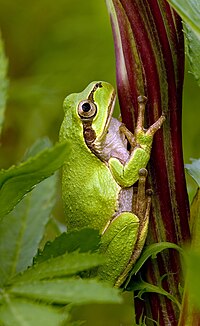| Japanese tree frog | |
|---|---|

| |
| Hyla japonica resting on a plant. | |
| Scientific classification | |
| Domain: | Eukaryota |
| Kingdom: | Animalia |
| Phylum: | Chordata |
| Class: | Amphibia |
| Order: | Anura |
| Family: | Hylidae |
| Genus: | Hyla |
| Species: | H. japonica
|
| Binomial name | |
| Hyla japonica (Günther, 1859)
| |
| Synonyms | |
| |
Hyla japonica, commonly known as the Japanese tree frog, is a species of anuran native to Japan, China, and Korea. H. japonica is unique in its ability to withstand extreme cold, with some individuals showing cold resistance at temperatures as low as −30 °C for up to 120 days.[2] H. japonica are not currently facing any notable risk of extinction and are classified by the IUCN as a species of "least concern".[3] Notably, H. japonica have been sent to space in a study that explored the effect of microgravity on H. japonica.[4] Hyla japonica is synonymous with Dryophytes japonicus.[5]
The Japanese tree frog lives in a variety of habitats such as wetlands, forests, rivers, and mountains. They are generally located near vegetation near water sources and forests. They are carnivores that prey on insects and spiders. Their average litter size is around 340–1,500 eggs, and their lifespan is usually around six years. There is an estimated 100 million of these frogs in Japan, but the accuracy is limited due to difficulty in counting.
- ^ Sergius Kuzmin; Irina Maslova; Masafumi Matsui; Fei Liang; Yoshio Kaneko (2017). "Dryophytes japonicus". IUCN Red List of Threatened Species. 2017: e.T55519A112714533. doi:10.2305/IUCN.UK.2017-1.RLTS.T55519A112714533.en.
- ^ Berman, D. I.; Meshcheryakova, E. N.; Bulakhova, N. A. (2016-11-01). "The Japanese tree frog (Hyla japonica), one of the most cold-resistant species of amphibians". Doklady Biological Sciences. 471 (1): 276–279. doi:10.1134/S0012496616060065. ISSN 1608-3105. PMID 28058600. S2CID 9770169.
- ^ IUCN (2004-04-30). "Dryophytes japonicus: Kuzmin, S., Maslova, I., Matsui, M., Liang, F. & Kaneko, Y.: The IUCN Red List of Threatened Species 2017: e.T55519A112714533". doi:10.2305/iucn.uk.2017-1.rlts.t55519a112714533.en.
{{cite journal}}: Cite journal requires|journal=(help) - ^ Izumi-Kurotani, A.; Yamashita, M.; Kawasaki, Y.; Kurotani, T.; Mogami, Y.; Okuno, M.; Oketa, A.; Shiraishi, A.; Ueda, K.; Wassersug, R. J.; Naitoh, T. (1994-08-01). "Behavior of Japanese tree frogs under microgravity on MIR and in parabolic flight". Advances in Space Research. 14 (8): 419–422. Bibcode:1994AdSpR..14h.419I. doi:10.1016/0273-1177(94)90434-0. ISSN 0273-1177. PMID 11537951.
- ^ "AmphibiaWeb - Hyla japonica". amphibiaweb.org. Retrieved 2022-10-26.
